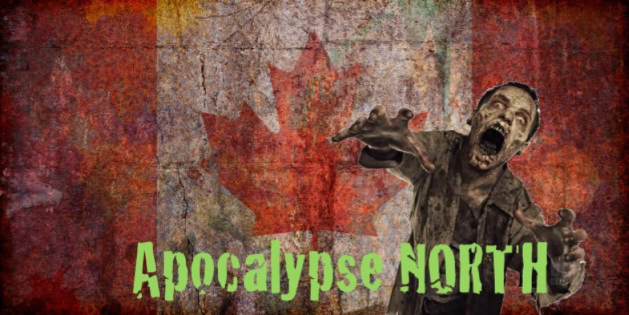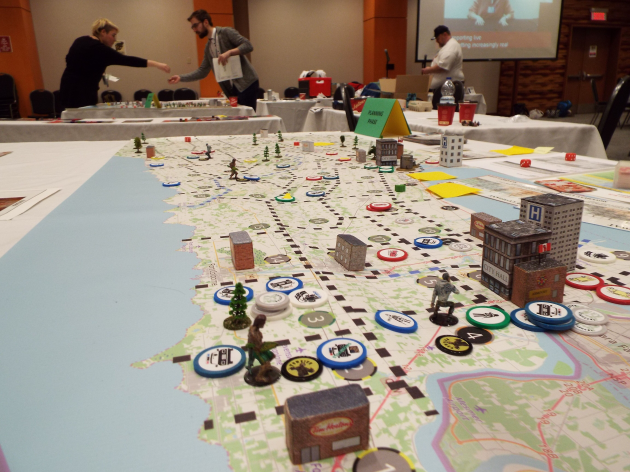
On February 17, some one hundred participants took part in the fourth annual McGill megagame, APOCALYPSE NORTH.
The United States is descending into chaos as it is overrun by mindless undead abominations. Can Canada survive the murderous zombie menace from the south? Can Ottawa, Québec, and Ontario overcome their differences in time?
Players assumed the roles of federal and provincial politicians, military commanders, local mayors, police and fire chiefs, public health officials, scientists, First Nations leaders, the media, and even local franchisees of a national doughnut chain. A description of the roles and some basic game mechanics can be found here.
APOCALYPSE NORTH was a non-profit event organized by PAXsims and cosponsored by the McGill Political Science Students’ Association (PSSA), International Development Student’s Association (IDSSA) and Sociology Students Association (SSA). Tim Hortons even threw in some free stuff too!

A History of the Apocalypse
The zombie outbreak had started a few weeks earlier, at—where else—the Centers for Disease Control in Atlanta. It soon started spreading across the United States. Random acts of violence by once law-abiding citizens caused growing fear, leading several states to declare a state of emergency and call out the National Guard. UN military personnel were deployed to protect critical national infrastructure. Growing numbers of frightened refugees began to arrive in Canada. Most were simply refugees, but some were armed survivalists who were reluctant to part with their weapons in the midst of a possible undead armageddon. Still others were infected, and might become zombies at any time.
This slideshow requires JavaScript.
The federal government moved fairly quickly to declare an emergency under the Emergencies Act on Day 2, thereby hastening the mobilization of both civilian and military assets. Later Ottawa also closed Canadian airspace to American aircraft, although several flights landed nonetheless.

A federal cabinet meeting underway.

Federal officials and Canadian Forces commanders discuss the growing crisis.
However, in southwest Ontario (Windsor – London), the Niagara peninsula (Niagara – Hamilton), and St. Laurent (Cornwall – Châteauguay – Saint-Jean-sur-Richelieu), local officials complained that Ottawa was slow in deploy resources. The Ontario and Québec governments joined the chorus of criticism, which became a frequent theme of periodic live CBC news reports. All this was much to the annoyance of the commander of Canadian Special Operations Forces Command, who was busy airlifting in teams from Joint Task Force 2 and the Canadian Special Operations Regiment to deal with zombie incursions across the border from upstate New York and Vermont.

Players (and yours truly) busy at the national map.
Not so far away, Fort Drum—home of the US 10th Mountain Division—was overrun. Unable to obtain prior permission from Canadian authorities, a quick-thinking commander for the 10th Aviation Regiment evacuated survivors by helicopter to Cornwall, Ontario. Thereafter, these US choppers would prove invaluable in ferrying casualties and personnel around the area.

The game underway.
This slideshow requires JavaScript.
Buffalo and Detroit fell, increasing the number of refugees—and zombies—entering Canada. Some arrived in Sault Ste-Marie, escorted by the elements of the Michigan National Guard 107th Engineer Battalion and remnants of the Michigan state police. They were sent back to the US, where a refugee camp was established.
Things were at their worst in Windsor. The city hall was overrun, and the mayor and police chief had to flee for their lives. They regrouped at Windsor airport, which was cleared of zombies. With much of southwest Ontario overrun, a massive airlift was undertaken to evacuate refugees to safer areas.

Police and reservists respond to zombie infestations in Niagara.
In Sarnia, a fire caused a massive explosion of the various chemical and fuel tanks there.

Zombie spreading through southwest Ontario. A 5 alarm fire can be seen in Sarnia (bottom left).
South of the border, Mar-a-Lago was overrun and contact was lost with President Trump. Vice President Pence thus assumed the reigns of power. The US Embassy in Ottawa received information that one group of CDC scientists, led by famed microbiologist Ernest Zrump, were holed up at Atlanta airport. Could Canada rescue them? They might prove invaluable in the search for a cure.

The crisis grows.
Canada’s elite JTF2 special forces undertook the mission. While they successfully entered the airport terminal, the sound of breaching charges and gunfire soon attracted hordes of undead to their location. They, and the CDC scientists, were lost.
At the Niagara and St. Laurent maps, refugee camps were established for American arrivals, several of them equipped with quarantine facilities and security. The United Nations High Commissioner for Refugees (UNHCR) and the World Health Organization (WHO) provided useful technical advice. Another refugee camp was established on the outskirts of Toronto to accommodate the large number of refugees arriving there. The city of Montreal proved especially adept at dealing with the occasional zombie washed down the St. Lawrence River, while refugees were screened and escorted to nearby camps.

Québec officials discuss the crisis.
The Public Health Agency of Canada was busy working towards a cure. Progress was slow, however, and hampered by poor coordination. The First Nations had information that the zombie plague was endemic to North America, and identified the location of an ancient, pre-colonial zombie burial pit that might contain vital clues. However, it was in a zombie infested area southwest of London, Ontario, and no one was able to reach it. Brilliant McGill University microbiologist Dr. Josephine Brant, herself of Mohawk ancestry, diligently worked on a cure.

Mohawk militia protect the Akwesasne (and St. Regis) reserves, while the CBSA secures Cornwall despite a major fire there. To the north, local police, OPP, RCMP and Canadian military units deal with zombie infestations.
Meanwhile, Tim Hortons—which, unbeknownst to players, was not just a doughnut chain, but also a secret zombie-fighting organization—was working on countermeasures. It also sought to keep its various retail outlets open, providing doughnuts, ice caps, and coffee to hard-working emergency service personnel. At one point, a suspicious federal government considered nationalizing the company, but backed off when it became clear the move would encounter significant political opposition.

This particular Tim Hortons was overrun by the undead.
Federal-provincial tensions reached the point that Ontario and Quebec announced the formation of a “New Canada” that would assume the lead in fighting the apocalypse. However, this made little difference on the ground, where RCMP and Canadian Forces units continued to adhere to instructions from Ottawa. (The Canadian Border Services Agency and Coast Guard rather hedged their bets.)

The Prime Minister (right), in discussions with the Quebec and Ontario premiers.
Another complication was provided by the growing number of American survivalist militia in Canada, led by the mysterious “Colonel X.” While these fought the zombie hordes, they also seized Owen Sound and the Bruce nuclear power plant, hoping to establish there a new, heavily fortified society that could withstand the apocalypse. When talks failed, they were forcibly disarmed by the Royal Canadian Regiment and other Canadian military units in a rather bloody fight.

Zombies infest Sault-Ste-Marie, Sudbury, and Barrie. Col. X and her militia have briefly taken over Owen Sound.
This slideshow requires JavaScript.
Washington DC was overrun. New York and Boston fell too. In far-away Los Angeles, Nancy Pelosi was sworn in as President.

Dick Danger (right) makes an appearance.

The strategic map, late in the game. The Bruce nuclear facility has been recaptured, but Colonel X is still hiding in the woods nearby. Zombies are advancing eastwards from Sault-Ste-Marie. Canadian forces are assisting Vermont (which is almost Canadian anyway).
No account of the crisis would be complete, of course, without mention of Dick Danger, famed star of the presciently-named reality television show Apocalypse: Survival. Dick toured afflicted areas, lent his own special brand of help, and even took part in a national television appeal for calm.

Dick Danger drops by Tim Hortons.

The US military attaché consults with the Canadian Chief of the Defence Staff as the American ambassador looks on.
And after seven hours of play, it all came to an end. Large areas of southwest and northwest Ontario had been overrun by the undead. Things were rather better in Niagara and south of the St. Lawrence, however. Indeed, Ottawa authorized elements of the Royal 22e Régiment to proceed south of the border to Burlington, Vermont, where they successfully worked with Vermont and New York National Guard units to establish a zombie-free safe haven.

City officials in Montreal coped well with the apocalypse.

Southwest Ontario under siege.
Game Mechanics and Reflections
Overall, things worked very well. We should have done a post-game survey, but forgot to prepare one. Nevertheless, participant feedback has been positive.
The game rules were a modified version of the Northland rules we had used back in July 2017, which in turn were a modification of Jim Wallman’s Urban Nightmare: State of Chaos rules used in the rest of that wide area megagame. It would have been nice to have finished the modified rules and other game materials a little more in advance, and to have had more time to work through things with the Control team (and made it a little larger) but every did an excellent job of adjudicating on the fly.

The St. Laurent map.
The maps were area movement maps produced via graphic arts wizard Tom Fisher, with some 3D elements (zombies, buildings, forests) added for visual appeal and clarity. I thought they looked great. Our two game currencies were megabucks and Canadian smug self-righteousness cards, or Smuggies. The latter were frankly adorable.

Police, fire, and medical units deploy to protect Hamilton, Ontario.
Thanks to the technical wizardry of Tim Furlong, we had a television (webcam) studio set up in a nearby location, live-streaming news reports to the main room. This worked brilliantly, the CBC team were great, and players soon were eager to give interviews. I think it’s the first time this has been done in a megagame quite like this.

A live CBC news broadcast.
We divided the room with tables into Blue (local) and Red (national/provincial) zones, and players were limited to their half of the room unless they either had a purple badge or played a travel authorization card. Everyone could also meet in the foyer and meeting rooms. This caused a few minor traffic flow problems, but generally achieved the desired effect of creating information discontinuities.

The science/quest/investigation subgames (several of them developed by Vince Carpini) worked very well in most cases. Fuller player briefings would have been helpful—I simply ran out of game preparation time—but, with one exception, everyone unlocked all of the plot elements available to them (generally by collecting cards or doing things, which would then get them a new envelope with new tasks—much like an apocalyptic scavenger hunt). Overall, most players seemed very busy most of the time, although there were one or two who could have been given additional late-game challenges.
Because we didn’t have much playtest time, our “zombiemeisters” acted as a balancing mechanism, adding in extra challenges where appropriate, and backing off when players were overwhelmed.
Already we’re thinking ahead to next year. While there are many possibilities, I’m rather attracted to running a sequel game fifty years on, in a post-apocalyptic Great Lakes region….

Many thanks to everyone—players, Control team, and others‚ who made the game a success. Thanks too to Jim Wallman and Kevin Farnworth for the pics.



























It was originally based on UNSOC. However, in UNSOC the primary mechanisms for zombies spreading is… other zombies. In APOCALYPSE NORTH a major challenge is American refugees, who might turn into zombies (or armed survivalists). AN is rich with Canadian federal/provincial/municipal/First Nations politics, which isn’t present in UNSOC at all. Indeed, overall the game is perhaps a little more “realistic” in that sense—more emergency management, much less worrying about votes (which are largely absent).
How similar or different mechanically is this from Urban Nightmare: State of Chaos?
What a hoot!
– Chief of Defence Staff